#ancient cephalopod shells :>
Explore tagged Tumblr posts
Note
noooo
BEHOLD

fossils :>
Eats them
7 notes
·
View notes
Photo

Orthoceras vagans Fossil Orthocone | Ordovician Ashgill Series Rhiwlas Bala Wales UK | Genuine Specimen with COA
Enhance your fossil collection with this authentic Orthoceras vagans orthocone fossil, originating from the Ashgill Series of the Late Ordovician period, found in Rhiwlas, near Bala, Gwynedd, Wales, UK. This striking straight-shelled cephalopod is a genuine remnant of ancient marine ecosystems that existed over 445 million years ago.
Fossil Type: Orthocone Cephalopod
Species: Orthoceras vagans
Geological Period: Ordovician (~485 to 443 million years ago)
Geological Series: Ashgill (Late Ordovician)
Location: Rhiwlas, Bala, Gwynedd, Wales, UK
Scale Rule: Squares/Cube = 1cm (Please refer to the photo for full sizing details)
Specimen: The photo shows the exact specimen you will receive
Authenticity: All of our fossils are 100% genuine specimens and come with a Certificate of Authenticity
Geological and Paleontological Information
Orthoceras vagans was a type of extinct nautiloid cephalopod belonging to a group of straight-shelled marine molluscs that thrived in the Paleozoic oceans. Fossils from the Ashgill Series of the Ordovician represent some of the last cephalopod species before the major end-Ordovician extinction event.
Phylum: Mollusca
Class: Cephalopoda
Order: Orthocerida
Family: Orthoceratidae
Superfamily: Orthocerataceae
Geological Stage: Ashgill (approximately 449 to 443 million years ago)
Depositional Environment: Deeper marine shelf environment with fine-grained sediments like shales and limestones typical of the Welsh Basin during the Late Ordovician
Morphological Features: Long, straight shell (orthocone) with multiple internal chambers (phragmocone); transverse septa separate the chambers; central or subcentral siphuncle used for buoyancy regulation; external ornamentation may include fine growth lines and annulations
Notable: Orthoceras vagans and other orthocerids from the Bala region are crucial for understanding cephalopod evolution and paleoecology in the pre-extinction Ordovician marine environment
Biozone: Likely corresponds to the upper Ordovician graptolite or brachiopod biozones of the Ashgill Series, though exact zonation is site-dependent
Identifier: The species vagans has been recognized in European Ordovician fossil records and is frequently used in stratigraphic studies
Why This Fossil Is Special
This fossil provides a window into the Late Ordovician seas of ancient Wales and offers both scientific and aesthetic appeal. Its preservation in a region of high stratigraphic importance makes it valuable for collectors, educators, and geologists alike.
Why Buy From Us?
100% genuine fossil with Certificate of Authenticity
The item shown in the photos is exactly what you will receive
Ethically sourced from established UK fossil localities
Great for teaching, scientific research, collecting, or display
Own a rare and historically significant piece of Earth's ancient oceans with this Orthoceras vagans fossil orthocone from the Ashgill Series of Rhiwlas, Bala, Wales — an enduring relic from over 445 million years ago.
#Orthoceras vagans#Orthoceras fossil#fossil orthocone#Ordovician fossil#Ashgill fossil#Rhiwlas fossil#Bala fossil#Wales fossil#UK fossil#cephalopod fossil#straight-shelled nautiloid#certified fossil#genuine fossil#fossil with certificate#Paleozoic fossil#marine fossil#ancient sea life#natural history specimen
0 notes
Text

The distinctive pinhole eyes, leathery hood, and numerous tentacles of modern nautiluses were traditionally thought to represent the "primitive" ancestral state of early shelled cephalopods – but genetic studies have found that that nautiluses actually secondarily lost the genes for building lensed eyes, and their embryological development shows the initial formation of ten arm buds (similar to those of coeloids) with their hood appearing to be created via fusing some of the many tentacles that form later.
There's a Cretaceous nautilidan fossil that preserves soft tissue impressions of what appear to be pinhole eyes and possibly a remnant of a hood, so we know these modern-style nautilus features were well-established by the late Mesozoic. But for much more ancient Paleozoic members of the lineage… we can potentially get more speculative.
So, here's an example reconstructed with un-nautilus-like soft parts.
Solenochilus springeri was a nautilidan that lived during the Late Carboniferous, around 320 million years ago, in shallow tropical marine waters covering what is now Arkansas, USA.
Up to about 20cm in diameter, (~8"), its shell featured long sideways spines which may have served as a defense against predators – or possibly as a display feature since they only developed upon reaching maturity.
———
NixIllustration.com | Tumblr | Patreon
References:
Anthony, Franz. "500 million years of cephalopod fossils" Earth Archives, 19 Feb. 2018, https://eartharchives.org/articles/500-million-years-of-cephalopod-fossils/index.html
Klug, Christian, et al. "Preservation of nautilid soft parts inside and outside the conch interpreted as central nervous system, eyes, and renal concrements from the Lebanese Cenomanian." Swiss Journal of Palaeontology 140 (2021): 1-11. https://doi.org/10.1186/s13358-021-00229-9
Korn, Dieter, and Christian Klug. "Early Carboniferous coiled nautiloids from the Anti-Atlas (Morocco)." European Journal of Taxonomy 885 (2023): 156-194. https://doi.org/10.5852/ejt.2023.885.2199
Kröger, Björn, Jakob Vinther, and Dirk Fuchs. "Cephalopod origin and evolution: a congruent picture emerging from fossils, development and molecules: extant cephalopods are younger than previously realised and were under major selection to become agile, shell‐less predators." BioEssays 33.8 (2011): 602-613. https://doi.org/10.1002/bies.201100001
Mikesh, David L., and Brian F. Glenister. "Solenochilus Springeri (White & St. John, 1868) from the Pennsylvanian of Southern Iowa." Proceedings of the Iowa Academy of Science. Vol. 73. No. 1. 1966. https://scholarworks.uni.edu/pias/vol73/iss1/39/
Shchedukhin, A. Yu. "New Species of the Genus Acanthonautilus (Solenochilidae, Nautilida) from the Early Permian Shakhtau Reef (Cis-Urals)." Paleontological Journal 58.5 (2024): 506-515. https://www.researchgate.net/publication/384922837_New_Species_of_the_Genus_Acanthonautilus_Solenochilidae_Nautilida_from_the_Early_Permian_Shakhtau_Reef_Cis-Urals
Wikipedia contributors. “Nautilida” Wikipedia, 26 Nov. 2024, https://en.wikipedia.org/wiki/Nautilida
Wikipedia contributors. “Solenochilus” Wikipedia, 28 Apr. 2022, https://en.wikipedia.org/wiki/Solenochilus
#science illustration#paleontology#paleoart#palaeoblr#solenochilus#solenochilidae#nautilida#nautiloid#cephalopod#mollusc#invertebrate#art#doing the inverse of all those ammonite reconstructions that make them look like nautiluses
220 notes
·
View notes
Text
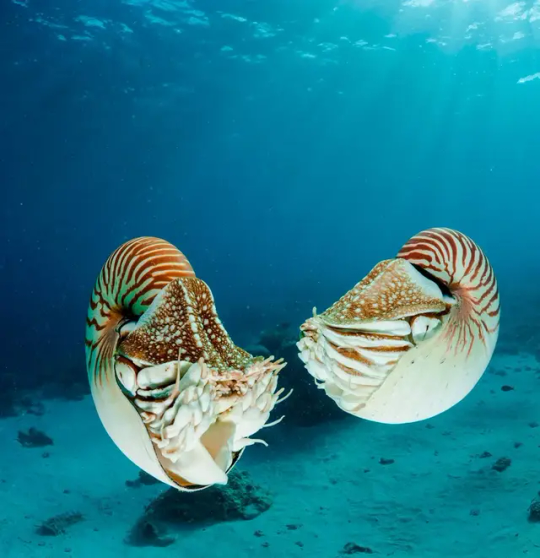

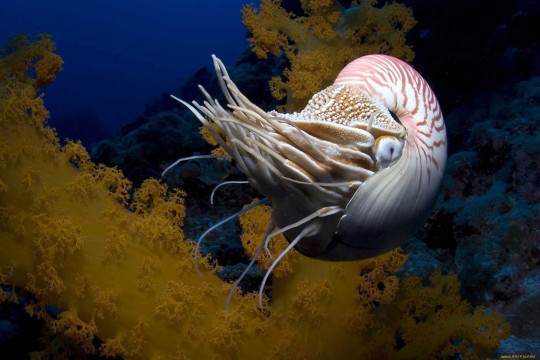
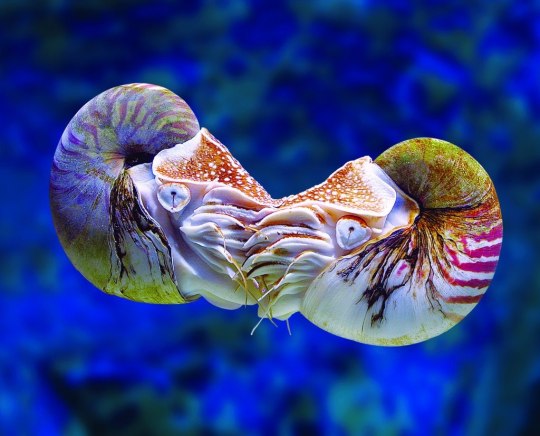
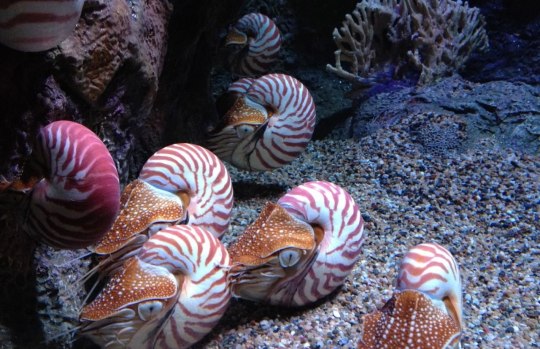
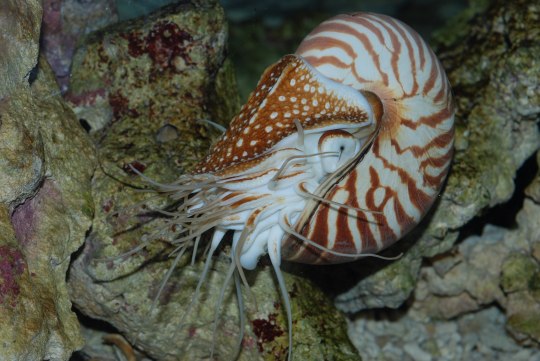
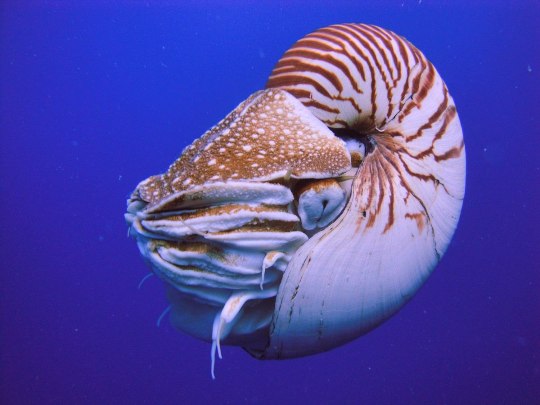
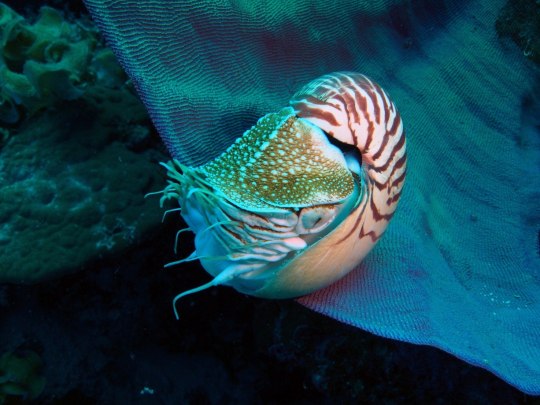




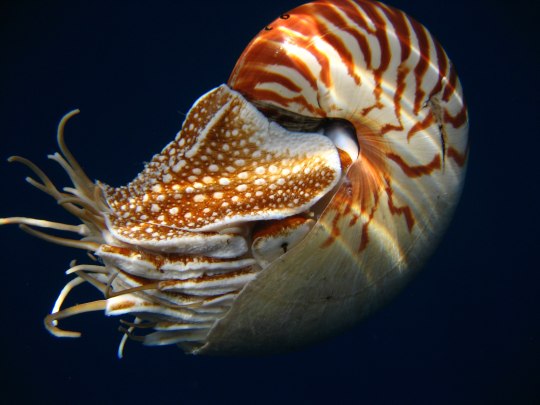
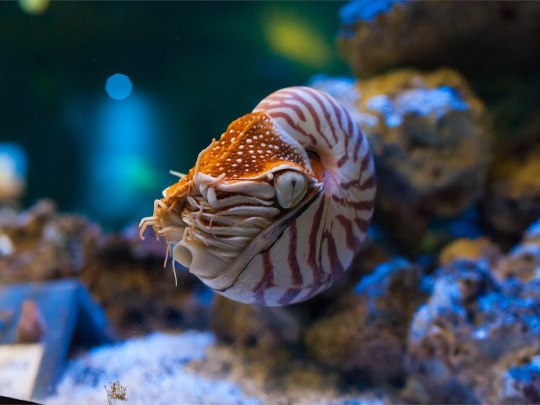
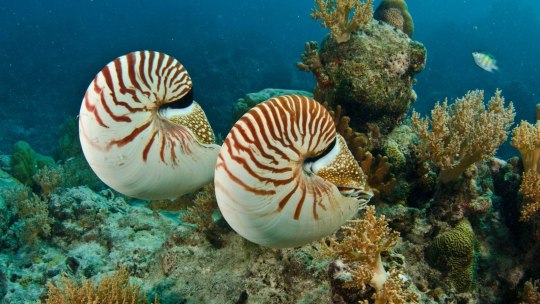
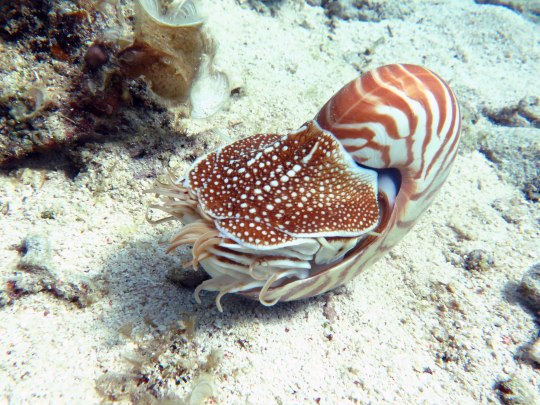
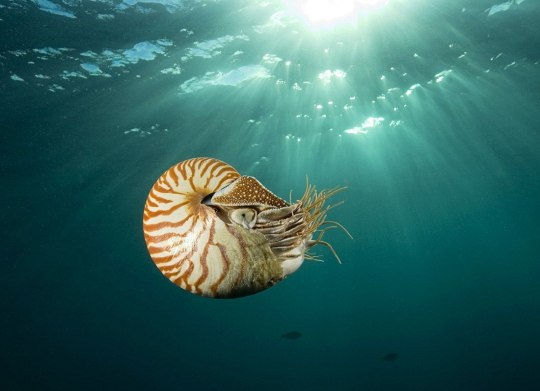

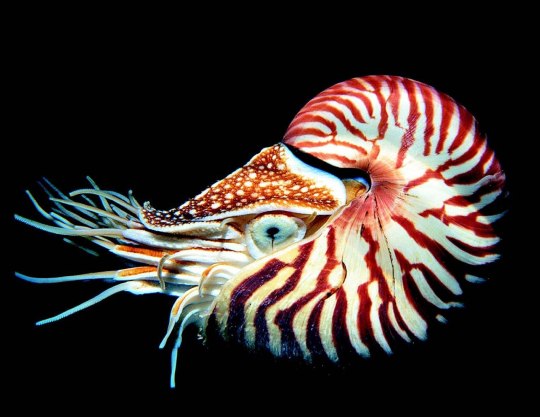

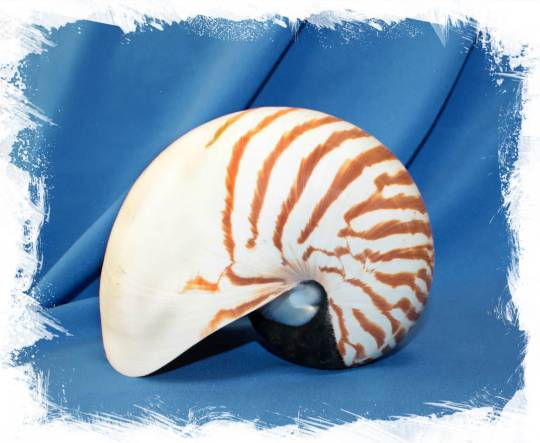
Наутилус (лат. Nautilus) — род головоногих моллюсков, которых относят к «живым ископаемым». Самый распространенный вид — Nautilus pompilius. Наутилусы относятся к единственному современному роду подкласса наутилоидей. Первые представители наутилоидей появились в кембрии, а его развитие пришлось на палеозой. Наутилиды почти вымерли на границе триаса и юры, но все же дожили до наших дней, в отличие от своих родственников аммонитов. Некоторые виды древних наутилусов достигали размера в 3,5 м. Представители самого крупного вида современных наутилусов достигают максимального размера в 25 см.
Спиральный «домик» моллюска состоит из 38 камер и «построен» по сложному математическому принципу (закон логарифмической прогрессии). Все камеры, кроме последней и самой большой, где размещается тело наутилуса с девятью десятками «ног», соединяются через отверстия между собой сифоном. Раковина наутилуса двухслойная: верхний (наружный) слой – фарфоровидный – действительно напоминает хрупкий фарфор, а внутренний, с перламутровым блеском – перламутровый. «Домик» наутилуса растет вместе с хозяином, который перемещается по мере роста раковины в камеру попросторней. Пустое жилище моллюска после его гибели можно встретить далеко от его места обитания – после гибели «хозяина» их раковины остаются на плаву и перемещаются по воле волн, ветров и течений.
Интересно, что двигается наутилус «в слепую», задом наперед, не видя и не представляя препятствий, которые могут оказаться на его пути.И еще одно удивительное качество этих древних обитателей Земли – у них потрясающая регенерация: буквально через несколько часов раны на их телах затягиваются, а в случае потери щупальца быстро отрастает новое.
Nautilus is a genus of cephalopods, which are classified as "living fossils". The most common species is Nautilus pompilius. Nautilus belong to the only modern genus of the Nautiloid subclass. The first representatives of the Nautiloids appeared in the Cambrian, and its development took place during the Paleozoic. The Nautilids almost died out on the border of the Triassic and Jurassic, but still survived to the present day, unlike their Ammonite relatives. Some species of ancient Nautilus reached a size of 3.5 m. Representatives of the largest species of modern nautilus reach a maximum size of 25 cm.
The spiral "house" of the mollusk consists of 38 chambers and is "built" according to a complex mathematical principle (the law of logarithmic progression). All chambers, except the last and largest, where the nautilus body with nine dozen "legs" is located, are connected through holes with a siphon. The nautilus shell is two–layered: the upper (outer) layer – porcelain–like - really resembles fragile porcelain, and the inner, with a mother-of-pearl luster - mother-of-pearl. The nautilus's "house" grows with its owner, who moves as the shell grows into a larger chamber. The empty dwelling of a mollusk after its death can be found far from its habitat – after the death of the "owner", their shells remain afloat and move at the will of waves, winds and currents.
Interestingly, the Nautilus moves "blindly", backwards, without seeing or imagining the obstacles that may be in its path.And another amazing quality of these ancient inhabitants of the Earth is that they have amazing regeneration: in just a few hours, the wounds on their bodies heal, and in case of loss of tentacles, a new one grows quickly.
Источник:://t.me/+t0G9OYaBjn9kNTBi, /sevaquarium.ru/nautilus/, /habr.com/ru/articles/369547/, //wallpapers.com/nautilus, poknok.art/6613-nautilus-molljusk.html, //wildfauna.ru/nautilus-pompilius, /www.artfile.ru/i.php?i=536090.
#fauna#video#animal video#marine life#marine biology#nature#aquatic animals#cephalopods#Nautilus#nautilus pompilius#living fossils#ocean#benthic#coral#plankton#beautiful#animal photography#nature aesthetic#видео#фауна#природнаякрасота#природа#океан#бентосные#головоногие моллюски#Наутилус#живое ископаемое#коралл#планктон
189 notes
·
View notes
Text
If you asked me as a kid what my favorite animal was, there's a good chance I'd respond "chambered nautilus", though I probably would mispronounce it. I don't know if it's still my favorite but it's definitely up there in the pantheon of weird critters. For this Wet Beast Wednesday, I'll discuss my childhood favorite.
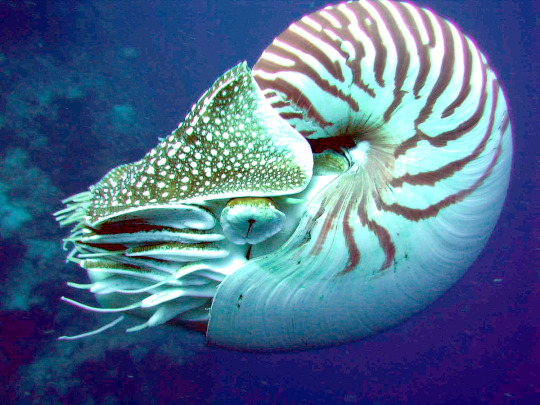
(image: a nautilus)
The nautilus is a cephalopod that lives in a curved shell and looks similar to (but is not closely related to) the extinct ammonites. There are 6 living species in two genera, but 90% of the time when someone is discussing nautiluses they are referring to the most well-known species: Nautilus pompilius or the chambered nautilus. Nautiloids are ancient, going back to at least the late triassic with their more primitive ancestors going back as far as the ordovician period, a time when only invertebrates and primitive plants occupied the land and true fish had not yet appeared. Because of their ancient history, nautiluses are sometimes considered living fossils. I have ranted before on how misleading the term "living fossil" is so I'll spare you that for now. Nautiloids are considered a sister group to the celoids, which contains all the squid, octopus, cuttlefish, and everything else we thinks of as cephalopods. Nautiluses should not be confused with paper nautiluses. Also called argonauts, paper nautiluses are a group of octopi that make an egg case which looks like a shell.
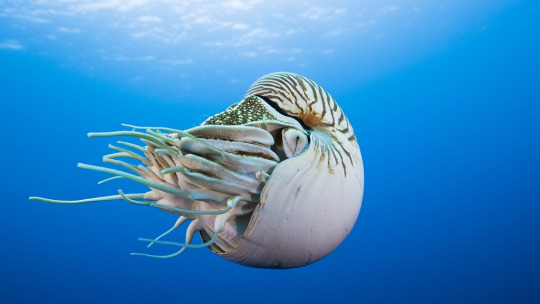
(image: a nautilus)
The most noticeable feature of a nautilus is its shell. The shell is smooth and finely curving, naturally growing in the shape of a logarithmic spiral (though not, as is commonly stated, a golden ratio spiral). The shell has a stripy outer layer and an inner layer coated with nacre. Internally, the shell is divided into camarae (chambers) separated from each other by walls called septa. Each septum has a small hole in it through which a strand of tissue called the siphuncle passes. Most of the nautilus's body is in the foremost and largest chamber. The shell grows new septa as the animal grows, with the nautilus's body moving to a new chamber as it becomes too large for previous ones. Juveniles are typically born with 4 septa, with adults having as many as 30. In addition to providing protection from predators, the shell is also key for regulating buoyancy. The septa can contain pressurized gas or water and the siphuncle regulates their contents by either adding or removing water to increase or decrease buoyancy. Because of its pressurized contents, the shell can only withstand pressure at depths up to 800 M (2,400 ft) before imploding. Oddly enough, nautiluses can be safely brought up from deep waters where most animals would be killed by the pressure changes. To move, the nautilus pulls water into the first chamber of the shell using its hyponome (siphon) and shoots it back out. The chambered nautilus is the largest species, with a maximum shell diameter of 25 cm (10 in), though most get no larger than 20 cm (8 in).
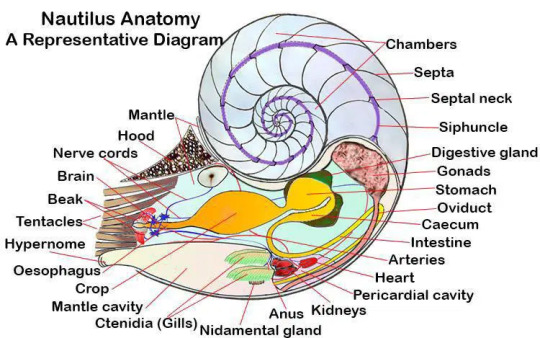
(image: a diagram of nautilus anatomy. source)
Where celoid cephalopods have tentacles, nautiluses instead have numerous cirri. Unlike tentacles, cirri are less muscular, are not elastic, and have no suckers. They are used to grab objects using their ridged surfaces and can hold in so hard that trying to take an object away from a nautilus can rip off its cirri, which will remain firmly attached. In addition, the nautilus has modified cirri that serve as olfactory receptors and a pair that serve to open and close the shell when the nautilus needs to retract into it or emerge. Nestled within the cirri is the beak, which is used to consume the nautilus's primary prey of invertebrates, though they have also been seen scavenging fish. Their eyes are less developed than most cephalopods, lacking a lens and consisting of a small pinhole that only allows the nautilus to see simple imagery. Their brains are differently structured than most cephalopods and studies have found them to have considerably shorter long-term memories.
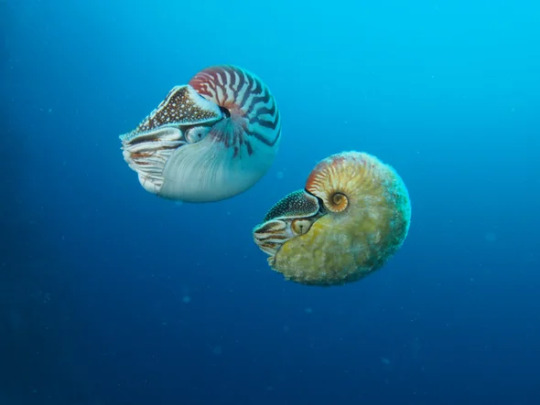
(image: a chambered nautilus (upper left) next to a rare Allonautilus scrobiculatus. source)
Cephalopod reproduction is quite different than that of other cephalopods. While most cephalopods are short-lived and semelparous (reproducing only once), nautiluses can live over 20 years and reproduce multiple times (iteroparity). They do not reach sexual maturity until around 15 years old, with females laying eggs once per year. Eggs are attached to rocks and take 8 to 12 months to hatch. Males have a structure called the spadix composed of 4 fused cirri that they use to transfer sperm to females. Females lose their gonads after laying their eggs and will regenerate them for the next year's mating season. Interestingly, male nautiluses seem to vastly outnumber the females. EDIT: @bri-the-nautilus in the replies found an alternate explanation for the disparity in male and female numbers you should check out. TLDR; the females are asocial.
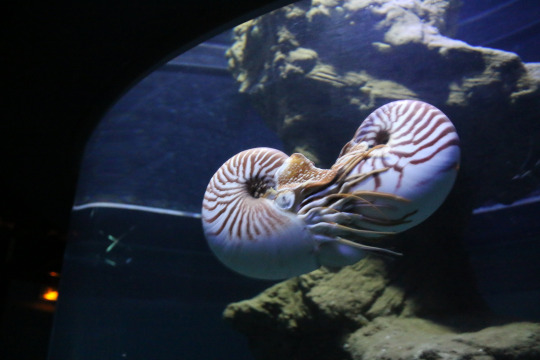
(image: nautiluses mating)
Nautiluses are found in the Indo-Pacific reagion of the ocean and can be found on the steep slopes of coral reefs. They prefer to inhabit waters several hundred meters down. It was once believed that they would rise to shallow waters at night to feed, lay eggs, and mate, but their vertical migration behavior has since been shown to be more complex than that. They have noon been fished by humans for their shells, which have become popular subjects in art and can be made into a number of decorative pieces. The nacre of the shell can be polished into osmeña pearl, which can be quite valuable. Demand for the shells combined with the late sexual maturity and low fecundity is threatening all the species. As of 2016, nautiluses have been added to the CITES Appendix II, making them protected by limiting international trade of their shells. Despite this, they are still threatened and require further protection

(image: a carved and painted nautilus shell from the Poldi Pezzoli Museum, Milan)
#wet beast wednesday#nautilus#chambered nautilus#cephalopod#marine biology#zoology#biology#ecology#animal facts
1K notes
·
View notes
Text
Taxonomy Tournament: Cephalopods
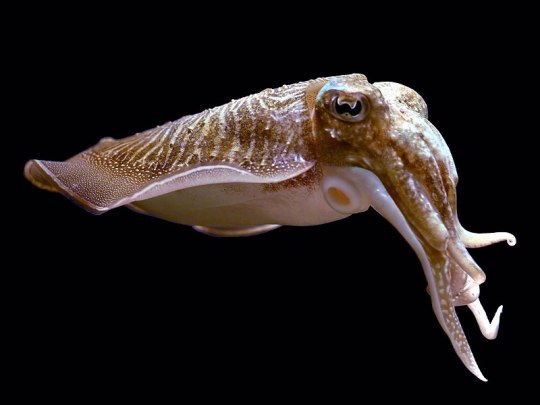
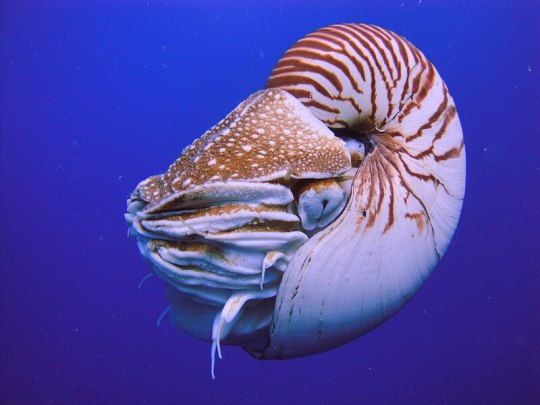
Sepiida. This order is made up of cuttlefish, which have an internal shell called the cuttlebone that is used to control buoyancy.
Nautilida. This order is made up of nautilis, which have a unique planispiral shell, and move via jet propulsion. They're morphologically veyr similar to their ancient relatives, and are often called living fossils.
#animals#biology#polls#poll tournament#zoology#cuttlefish#molluscs#cephalopods#spiralia#nautilis#Sepiida#Nautilida#0x29v0x56
226 notes
·
View notes
Text






Dive into the world of Orthoceras, where ancient cephalopods ruled the seas with their distinctive straight shells! 🦑 Their well-preserved fossils offer a fascinating glimpse into Earth's prehistoric past. 🕰️
#orthoceras#prehistory#prehistoric#paleobiology#paleozoic#paleontology#paleoart#paleoblr#paleo#marine animals#ancient animals#animal#animals#fossils#ordovician#marine biology#biology student#biology#biology studyblr#biology facts#science#zoology#science facts#education#discover#scicomm#study blog#studyblr#explore#simps for science
21 notes
·
View notes
Text
At level 30, Ancient Corphish evolves into Ancient Crawdaunt! Category: Noble pokemon Type: Water/Ghost Gender ratio: 50% male 50% female Origin: Ghost shrimp, samurai, spiny lobster, Ise Ebizo Name origin: Crawdad, taunt Ability: Hyper cutter, shell armour (with adapatbility as a hidden ability) Pokedex entry: Upon interviewing some people who fell for Ichigen's grift, I found that they are a popular pet in Oldale because crawdaunts are a great defence against cephalopod pokemon. These brutal pokemon will viciously slice their prey apart using their spiny claws. Crawdaunts are so effective at killing that they have managed to wipe out any and all pokemon in the area; luckily though, they are still loyal to humans.

The shiny turns the eyes obsidian black.

Ancient Crawdaunt has a signature move called Shell Blade; a water type physical move that always deals critical hits.
2 notes
·
View notes
Note
Do you know any ancient sea creatures that you really like, like any specific trilobites or dickinsonia or the famous animalocaris
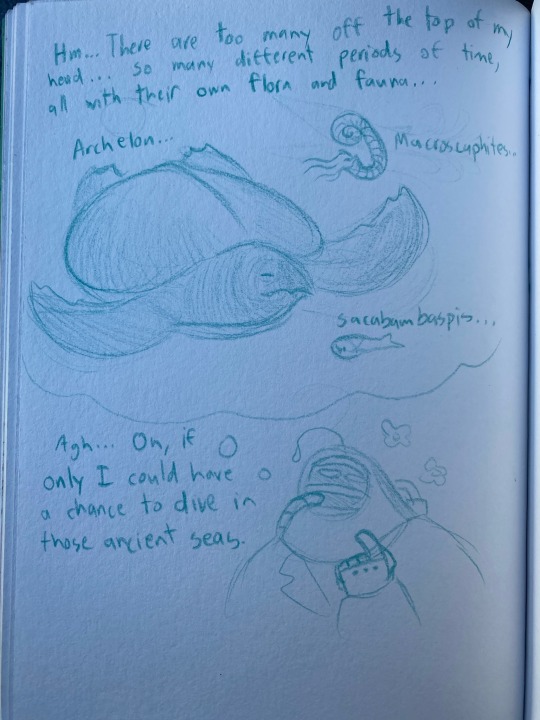
This world has lived for billions of years, and through out the ages the ocean was filled to the brim with a whole plethora of sea creatures. To the Cambrian Explosion to the age of the dinosaurs, countless species “rules” the oceans. Forgive my sketches here, they could never encapsulate the true glory and scale of these creatures.
One creature that may seem familiar is the Macroscaphite, belonging to the extinct subclass of Cephalopods named Ammonoidea. You may know them better as the common name of “ammonite”. One may be familiar with the modern day Nautilus and assume that it is a long lasting member of this subclass due to their striking similarities, but ammonite were actually closer related to the subclass Coleoidea. This is the group of shell-less cephalopods such as octopi and squid.
Back in the day many ammonites had rather absurd shells, not just the polite little spiral you may sea in many textbooks. Some where cones spiraling up in the most ridiculous manner, some possessed dangerous ridges and spikes, others… well, as you can see with Macroscaphite… I cannot even begin to describe what this shape reminds me of. It is somewhere between a trombone, a paper clip, and a slide whistle. It is as if they all came together and had an abyssal child together, how beautiful.
Sacabambaspis is a mouthful of a name, which is funny to conchsider when you remember that it is a jawless genus of fish. ��But Mary,” you say, “how can this fish eat without a jaw?” For this you can look to living examples such as lampreys and hagfish. These specimen can latch onto larger animals like a suction cup. Adult lampreys are parasitic in nature, scraping a “tongue” against their host for a good mouthful of meat. This does not kill the host, that would be bad for the parasite, but it is rather uncomfortable to say the least. I’m saying this from experience. Not enough is known about Sacabambaspis as a whole to say if it was a parasite itself. It is likely that it employed a similar sucking motion to collect food.
As for the Archelon… What a magnificent creature it is, no? The largest documented turtle to swim the seas. Approximately 15ft from head to tail, this reptile would’ve been taller than I am! Can you imagine that? Someone larger than me? There are the boss cogs, yes, but outside of that bunch there aren’t many who rival me in size. Much like the living leatherback sea turtle, Archelon would’ve had a leathery shell, or carapace, unlike other hard shelled turtles. Who knows what prehistoric jellyfish or squid this beast may have consumed. It is hard to imagine such a large fortress of an animal to be contested in its oceans, but during its life the Archelon would’ve shared its waters with large marine reptiles such as the mosasaur.
[The Deep Diver sighs, shutting her notebook and tucking it into a comically small pocket on her suit.]
If only I could have the chance to meet these creatures, even if it is only for a moment… oh well. No reason to dwell in the past, to have suck silly dreams swimming around in my helmet.
36 notes
·
View notes
Text
We continue our exploration into the world of animals with the mollusks. These links only scratch the surface of the biodiversity of these groups, but they are a fun place to start!
Do you know what’s inside of a snail shell? Do you know how they are made? Do you know the parts of a snail’s shell?
Watch a mystery snail lay eggs!
Catch a glimpse of this snail’s tooth-lined radula as it rasps across the aquarium glass.
George was the last of his kind.
How do freshwater snails impact their natural habitats? How do they impact places they are introduced to?
What are slugs, and how do they survive without a shell for protection?
Many strange and mysterious gastropods live in the ocean, including the beautiful nudibranchs and the voracious cone snail.
The abalone is an important part of Monterey Bay’s natural heritage. Can it be restored?
Limpets may seem passive, but they have strategies to protect themselves from hungry starfish.
Some marine gastropods, the sea butterflies and sea angels, leave the benthos to soar through the seas.
Learn to identify bivalve shells.
If you stare into the scallop, you will see it stare back at you. And then swim away.
Bivalves can save human lives, cleaning water and protecting coastlines from storms.
Some clams bore into wood and rock, feeding as they burrow.
Watch clams burrow and shuffle around using their muscular foot.
Some mussels lure fish close to host their parasitic larvae!
What do you know about the Zebra Mussel?
What do you know about the Geoduck?
Next time you are at a rocky coastline or dock, keep an eye out for the armor-plated chitons! They’ll keep a thousand eyes out for you.
What is a tusk shell? What is a solenogaster?!
Cephalopods look pretty strange when compared to other mollusks. What is their anatomy?
Humboldt squid flash a strange language of colors as they hunt in packs.
Some squid leap from the water like flying fish!
In the deep sea, some species of squid can grow large enough to inspire tales of kraken and sea monsters. Others glitter in bioluminescent schools.
Cuttlefish are really cool and you should learn more about them!
Vampyroteuthis infernalis: Ancient Vampire of the Abyss
Do you know what a nautilus is?
Do NOT touch the blue-ringed octopus.
Befriend the giant pacific octopus!
Watch a deep-sea octopus guard its eggs for four years.
Behold the octopus and its amazing array of abilities!
0 notes
Text
Uncovering the Enigmas of Cephalopod Remains
With the help of cephalopod fossils, explore the depths of ancient oceans and be amazed by the ancestors of modern squids and octopuses, whose petrified shells provide insight into their evolutionary history and the waters they once called home. For more information visit our website: https://www.fossilageminerals.com/
0 notes
Photo

Dawsonoceras annulatum Orthoceras Fossil Orthocone | Wenlockian Silurian Ledbury UK | Genuine Specimen with COA
Own a remarkable piece of British geological heritage with this genuine Dawsonoceras annulatum orthocone fossil from the Wenlockian stage of the Silurian period, discovered near Ledbury, Herefordshire, UK. This straight-shelled cephalopod fossil offers insight into marine life that thrived over 425 million years ago in the shallow seas of the ancient Welsh Borderlands.
Fossil Type: Orthocone Cephalopod
Species: Dawsonoceras annulatum
Geological Period: Silurian (~443 to 419 million years ago)
Geological Stage: Wenlockian (Wenlock Epoch, ~433 to 427 million years ago)
Location: Ledbury, Herefordshire, United Kingdom
Scale Rule: Squares/Cube = 1cm (Refer to photo for full sizing)
Specimen: The photo shows the actual specimen you will receive
Authenticity: All of our fossils are 100% genuine specimens and come with a Certificate of Authenticity
Geological and Paleontological Information
Dawsonoceras annulatum is a genus of straight-shelled nautiloid cephalopods found in Silurian marine strata. This genus is distinguished by its distinctive annulate (ringed) ornamentation along the length of its orthoconic shell. Specimens from the Ledbury area are preserved in marine sedimentary rocks deposited in a warm, shallow sea during the Wenlock Epoch.
Phylum: Mollusca
Class: Cephalopoda
Order: Orthocerida
Family: Dawsonoceratidae
Superfamily: Orthocerataceae
Depositional Environment: Shallow marine platform with low-energy carbonate and calcareous mudstone deposition
Morphological Features: Long, straight (orthoconic) shell with regularly spaced transverse ridges (annulations); internally chambered phragmocone with a central or subcentral siphuncle used for buoyancy control
Notable: Dawsonoceras annulatum is a well-documented nautiloid species from the Wenlockian of Britain and contributes significantly to our understanding of Silurian marine ecosystems
Biozone: Likely falls within graptolite or brachiopod-based Wenlock biozones; specific assignment requires precise stratigraphic positioning
Identifier: Originally described in 19th-century paleontological literature; well-represented in British Silurian collections
Why This Fossil Is Special
This orthocone fossil from Ledbury is not only aesthetically striking with its annulated shell but also holds scientific importance. It comes from the Wenlockian strata of the Welsh Borderland, a globally recognized reference area for Silurian stratigraphy.
Why Buy From Us?
100% genuine fossil with Certificate of Authenticity
What you see is what you get—specimen in photo is the one you will receive
Ethically sourced from historically significant UK geological formations
Excellent for collectors, educators, and fossil enthusiasts
Bring home a captivating relic from Earth’s ancient oceans—this Dawsonoceras annulatum fossil from the Wenlockian Silurian seas of Ledbury, UK is a true collector’s treasure from over 425 million years ago.
#Dawsonoceras annulatum#Orthoceras fossil#fossil orthocone#cephalopod fossil#Silurian fossil#Wenlockian fossil#Ledbury fossil#UK fossil#straight-shelled nautiloid#certified fossil#genuine fossil#fossil with certificate#Paleozoic fossil#natural history#marine fossil#fossil collection#ancient sea life
0 notes
Text


Ever see those ancient cephalopods with the reeaallllyy long shells on em? Those guys are sooosososososoos cool!
The other one is from that Jacob geller video about freezing ❄️❄️❄️📹 to death I think (you should really go watch that, the video goes hard!!!!!!
1 note
·
View note
Text
Lecture: A Presentation involving Smell and a Whale (by David Haines) (8.8.23)
Sensory experiences are intrinsic to our relationship with art.
Materials/images/themes and the language/history surrounding them also operate within art as an interconnected system.
Art+ The Olfactory White Whale:
Haines started the lecture by giving us some perfume strips.
When I smelt them, it was a cross between acidic and sweet, reminding me of diluted apple cider vinegar and certain perfumes (e.g. my dad’s eau de toilette).
Turns out that the perfume was ambergris, which is the by-product of sperm whale digestion (perhaps through the secretion of bile - to protect its digestive tract against the beaks and shells of cephalopods).
Resistance between whales vs. their own diet, as well as the conflict between the lives of whales vs. people’s desire to fulfil their own needs/luxuries.
Note: This is already the strangest (yet simultaneously the most enlightening) lecture I've ever had the pleasure of being in.
Ambergris has a relationship to both chemistry and economic trade - therefore, nature should not be separated from culture.
Mercantile value since Ancient Egypt.
Alongside pearls, ambergris was considered an extremely valuable commodity.
In the 16th and 17th centuries, no laws existed regarding the ownership of ambergris, facilitating both illegal and legal trade.
Involvement in whaling industry in 19th and 20th centuries (economic exploitation of the ocean).
Despite whales being protected and illegal trade of ‘whale products’ being banned under various laws, some laws (e.g. UK and EU) consider ambergris an excretion in the same way as faeces and therefore trade is still considered legal.
In other laws (e.g. Australia), this does not apply.
Used for perfume/incense.
However, the olfactory molecules naturally found in ambergris are now being taken over by synthetic counterparts.
But is it even possible to achieve the natural scent of ambergris?
Was also used in cuisine.
Reports suggest that one of King Charles II’s favourite dish was eggs and ambergris.
Ambergris was used in ice cream, bread puddings, cocktails, chocolate, etc.
However, research suggests it contains a form of cholesterol as well as chemicals not too dissimilar to blood thinners (so not the healthiest).
Process to convert ambergris from a disgusting-smelling mass to a valuable commodity with a pleasant aroma.
0 notes
Text

Tartarus
though the mainlands geology is likely older than tartarus, and this peninsula is likely a massive volcanic crater, the life here is FAR more ancient, though certainly no less derived. many species here are downright unrecognizable to anything more specific than "amniota" or "fluffy" and even that can be tenuous. the plantlife is likewise very ancient, with some of the trees being more closely related to certain mosses than any flowering plant. a few relics from before such trees, and even, possibly, before *anything* that could be called a shark, call these forests home, having just survived.
though, such relics could just as well be derived, terrestrial sponges of some sort, especially given the multitude of otherwise fully marine life that is found on the trees, feeding on either aeroplankton of a wide variety, or the jay-sized dragon-stripping frog-mouthed bats that act as a top predator feared by all but the largest animals

the seas around this virtual island are just as diverse, though the fauna is much less ancient. indeed, one would be forgiven for mistaking the hunting porpoise, razor whales, or viper-seals for earth species, particularly the razor whale, though there are quite a few truly ancient clades remaining here, such as the viper seals.
even those therocephalians, however, are nowhere near the most ancient monsters in these old seas, as marine temnospondyls, harvested in the carboniferous, along with peculiar arthropods that have odd four-clawed appendages, which trace their lineage to an even older period, and finally the only truly endemic hadean life, which form most of the deep-sea reefs, and the closely related scylla, which prowls such reefs as an apex predator, though kraken regularly hunt them.
the true apex predators here, however, are the whales, and not just odontocetes, though southern porphyrios are easily the largest macroredators in these seas, and hunting porpoise the most common. cog-tooth whales are still noteworthy, being nearly as large as the physeteroid though much more common, as they have a very wide diet, crushing bone or shell of great mollusc or marine mammal, and slurping up boneless cephalopods or microscopic krill.
both of those are occasionally hunted by the porpoise, and some argue these wide-ranging sea-people are the true apex predators of the southern sea, though they can only do so with help from king serpents, whos greater size and agility allow for hunting of larger prey, though in many cases even these massive plesiosaurs require their smaller, and swifter, allies to harrass and track prey, particularly the color-changing ichthyosaurs and cephalopods.
Geography
as with all maps, these will focuse on terrestrial ecosystems, and as with all planetary maps, this will not be especially useful for anyone who wishes to live within the maps boders.
still, they should provide a rough overlay of the biota and appearance of the land within their borders, and thus have some use to researchers and settlers.
4 notes
·
View notes
Text
Taxonomy Tournament: Cephalopod Finale!
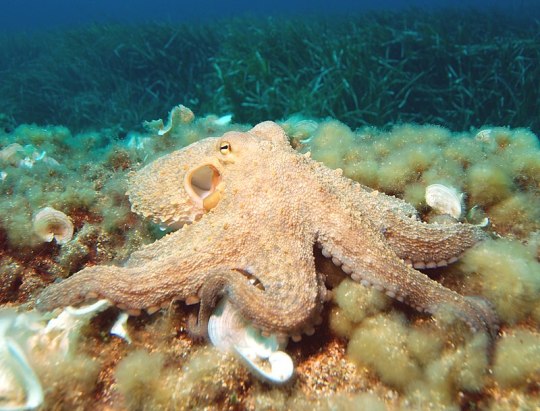
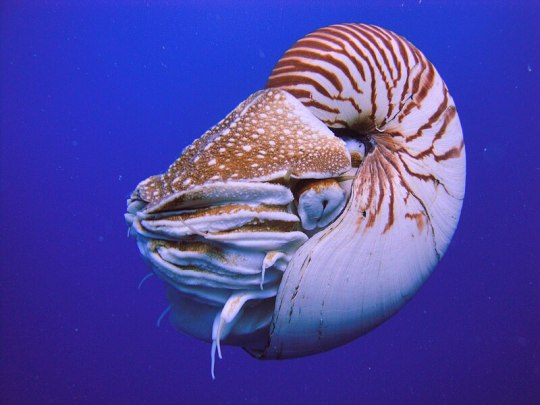
Octopoda. This order is made up of octopuses, predatory marine creatures with eight limbs. Their soft body allows them to squeeze trhough small spaces. They are capable of camouflage and are among the most intelligent animals.
Nautilida. This order is made up of nautilis, which have a unique planispiral shell, and move via jet propulsion. They're morphologically veyr similar to their ancient relatives, and are often called living fossils.
#animals#biology#polls#poll tournament#zoology#octopus#octopi#octopuses#molluscs#cephalopods#spiralia#nautilis#Octopoda#Nautilida#0x15v0x2a
123 notes
·
View notes